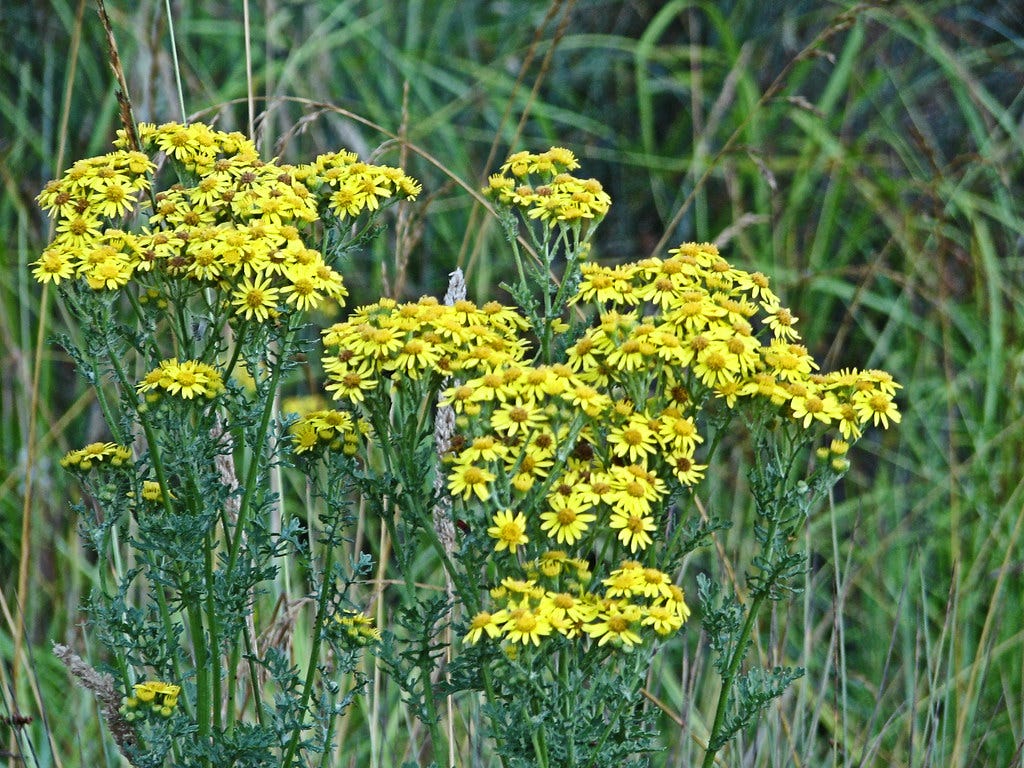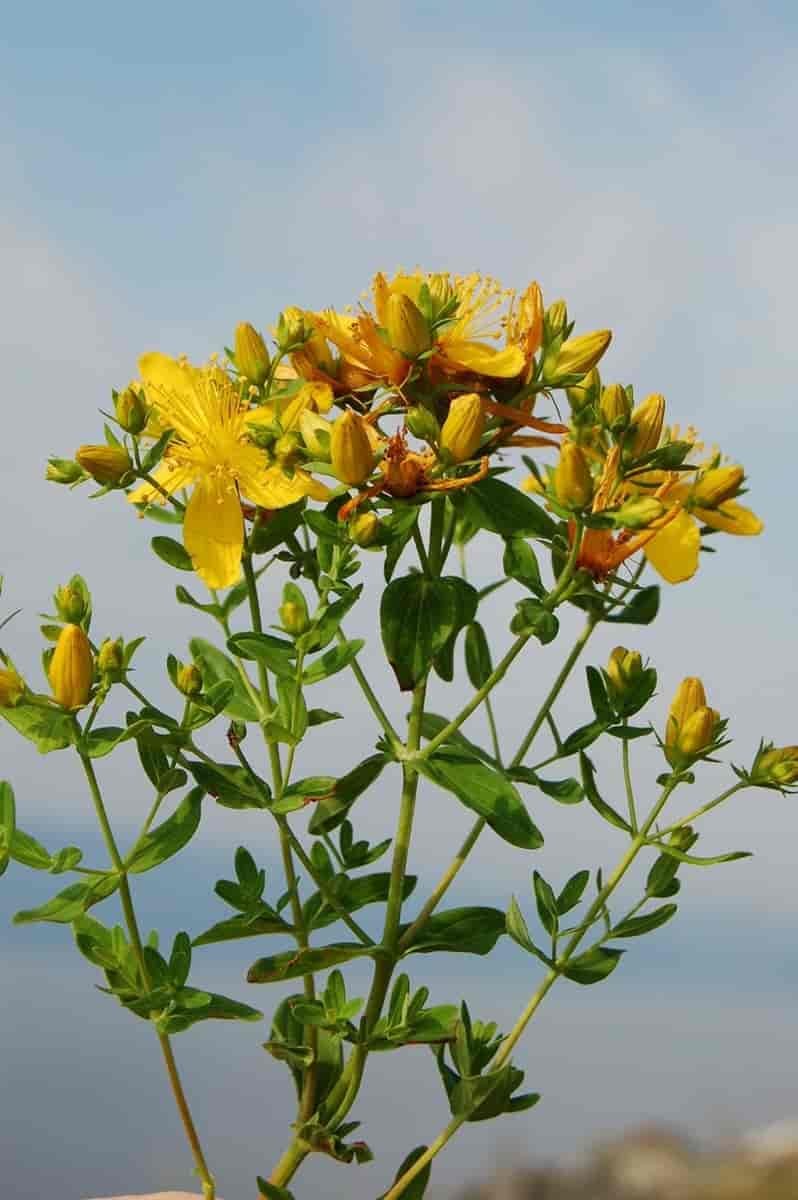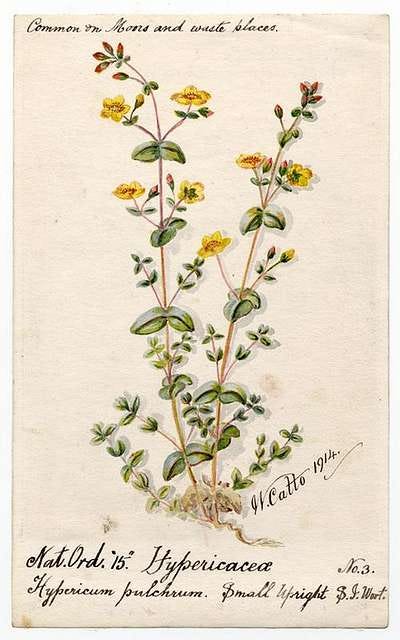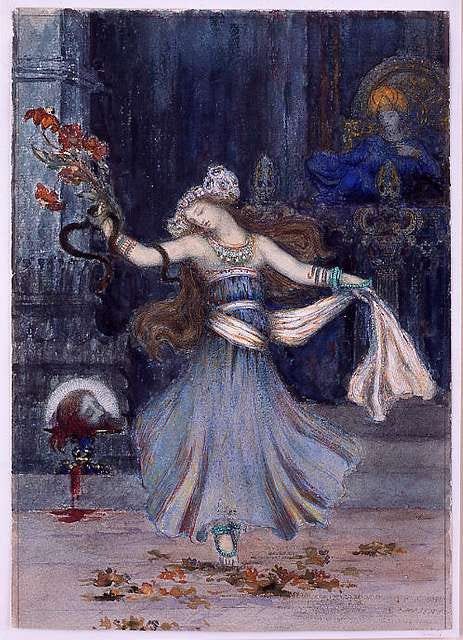ALSO KNOWN AS: Hypericum perforatum, Klamath weed, common goatweed, tipton weed, millepertuis
Not Chelidonium majus with its larger, more velvet leaves
or Tansy Ragwort with its narrow petal, this looks more like an aster, or a daisy
How to know:
Opposite oblong leaves clustered along the stems
showy yellow flowers
rusted dead flowers that extend below the new blooms
growing together in clusters
On warm June days I’ve collected St. John’s Wort, thinking it would solve an existential dread. I’ve dipped bags of these flowers, harvested from lawns, meadows, and clearings beside parking lots into steaming bowls of water, but I didn’t see effects. So I moved on to some other woo woo remedies. But Saint John’s Wort kept growing, kept showing up everywhere - and then I heard that it was dangerous.
Saint John’s Wort likes poor soil. Tendrils from these plants will be the first to grow in a site whose land has been upturned, that’s why they congregate by abandoned lots and roadsides. You’ll see them in meadows, in coppery tangles. The five yellow petals are celebrated with showy sepals and tiny black glands around their edges. All the flowers in the hypericum family look the same: showy and bearded. There are 500 varieties of hyperium growing all over the temperate world varying from one to the other depending on their environment. But I think you’d know it when you saw it.
When you hold the leaves up to the sun, they glimmer with constellations of light that shine through minuscule pores like stained glass.
But the plant casts a long shadow. If taken alongside medication - or even without - its negative side effects are real and should be taken into account. There is no doubt that it has antibacterial, antiviral, and antioxidant effects and the polyphonic compounds can work with serotonin levels. If taken with pretty much any medication St. John’s Wort can bar the effect or make the side effects worse. And even if not taken along with medication they can cause sensitivity to sun, or, ironically, anxiety.
St. Johns Wort has been cultivated and wild throughout the world’s temperate regions of the world, but is Native to Eurasia and North Africa. It can grow up to one meter high and often has shoots that sprawl along the ground, twisting around other plants. For this reason it can be used for ornamental gardening.
While St. John’s Wort can be medicinal to humans it is toxic to livestock. With the 15,000 and 34,000 seeds it produces in a season, some of which can stay dormant for decades, it’s no surprise these plants are flagged as noxious weeds in the United States, South Africa, Australia, and South America.
It’s hard to imagine that these plants (and others) could contribute to making clouds, but land plants contribute to the behemoths in the sky. Saint John’s Wort in particular has sesquiterpene compounds which are used in sagebrush, ginger, and many other aromatic plants. A recent study conducted in the Cosmics Leaving Outdoor Droplets large cloud chamber has identified gaseous hydrocarbons that are released by plants with sesquiterpene potentially play a significant role in cloud formation in relatively pristine regions of the atmosphere. And water does trail this plant through in myth.
John was the immerser of those who came before Jesus, laying groundwork for a prophet who would baptize with spirit. He renewed Jesus in the River Jordan and was beloved among his followers. When this flower blooms in the tip of northern hemisphere summer, we too, swim and cool ourselves in the water on and around June 24th: St. John’s feast day.
He was killed in Galilee, Palestine, where the infamous Salome danced - perhaps the dance of seven veils. And St. John became tangled in a web of power manipulations. when you take the flower off it mooshes red in your hand. Perhaps this is the name for St. John’s Wort, for on the day he was beheaded, August 29th, those same brilliant blooms turn to red pods, which also release a soft red pigment. And Salome, according to Oscar Wilde, could at last kiss the lips of her beloved. When the flowers die when they become the color of rust. A hidden redness runs through this plant like blood.
Their flowers, pods, and stems have been used as a dye for pinks, reds, maroons, yellows or greens depending on the season and use of mordant.
In Ancient Greece Hippocrates and Pliny the Elder wrote about St. Johns Wort. Dioscorides wrote that it was good for hip ailments and used topically to treat burns and injuries to the skin.
Much of mythology around St. Johnswort could come from the physicality of the plant. It seems to be holding a secret language in its very form.
Nero had it in his panacea to protect him from poison. Medieval writers saw the pores in the leaves as an indicator that it is good for the skin. And the red that emerges when the flower as a sign that it can be used to heal open wounds. It was so powerful that just carrying it around in medieval Europe was believed to protect against spirits.
From being heralded as a remedy for broken bones, or treating the most bilious melancholy, to an herb that a French medical book in 1822 deemed as one with “imaginary virtues” it’s hard to know what to think.
St. Johns Wort has been known to alleviate mild to moderate depression in patients without common side effects that other remedies may have, and more effectively than tricyclic, or, basically, over the counter antidepressants. It has been known to aid with menopause and PMS symptoms. It’s anti-inflammatory properties have allowed it to be applied to the skin to help heal wounds and burns. But it’s important to remember adverse effects combined with other drugs, especially, if one is going through any kind of severe anxiety or depression St. Johnswort is not a cure-all.
Taking St. John’s Wort is like a day in the sun. It can be a bath of warmth, stirring an inherent joy within us, but it can mean a kind of heat exhaustion in heart palpitations and a sensitivity to light.
Compounds and flavenoids have been extracted from this plant to use in drugs that are sold in Europe. It’s not a matter of if Saint John’s Wort is effective but how it is disseminated and used. And it is still the highest selling herbal remedy in the United States.
The truths about this storied plant are vague and obscured by myth. But so are many truths about the healing qualities of many plants. There is little we scientifically know and a lot of stories passed down. All in all, just because St. Johns Wort has medicinal properties does not make it inherently good. All things have a poison. In many cases even the most powerful medicines hold those opposites. With more attention and careful consideration paid to the plants of the world, we may learn to use St. John’s Wort to also part the clouds and give us clarity on how it works. Perhaps there is even more to them than even the myths hold.
myth for St. Johns Wort
There was a traveler who had been everywhere in the world. She had slept beside vast oceans and shivered at sunrise on countless mountains. She had been around the world many times over and had met all kinds of people and animals.
And soon she became bored and tired. She traveled on her feet. She traveled on trains and in cars. She traveled in airplanes and became very used to what it meant to live in motion. She was always going in lines: here and there. But she was tired.
One day she fell asleep in a field a man with a beard came to her who was all in gold and whose hair was red. He told her he was goatweed.
The plant told her that other worlds exist. But not really in the way she had thought. By traveling across space for infinite amounts of time. The plant told her that if she looked through his leaves, she could see the suns of other worlds shining. And the veins along the skin were roads. And if she tasted the plant she would know what it was like to taste another place.
“All sensations are portals.” The plant said.
forager friendly!
Yes, yes, this is. But please use care when using it with any other medication. Talk to your doctor if you take any kind of medication and are interested in using St. John’s Wort.
But you can use this plant as a dye! Go forth!
Sources
https://en.wikipedia.org/wiki/Sesquiterpene
https://www.ncbi.nlm.nih.gov/books/NBK557465/
https://thefoxandtheknight.com/st-johns-wort-natural-dyeing-history-and-medicinal-uses/
https://kathryndavey.com/st-johns-wort-natural-dye/
https://www.nature.com/articles/ngeo1852
Nature’s Pharmacopeia by Dan Choffnes
Healing Herbs a to Z by Diane Stein
https://www.mountsinai.org/health-library/herb/st-johns-wort








